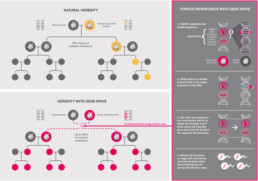Gene Drives: a genetic chain reaction that modifies natural species
„The bottom line is that making a standard, self-propagating CRISPR-based gene drive system is likely equivalent to creating a new, highly invasive species: both will likely spread to any ecosystem in which they are viable, possibly causing ecological change*.“
This is how Kevin Esvelt, US researcher at the Massachusetts Institute of Technology (MIT) in Boston, describes a discovery in which he played a major role. With the help of the so-called “genetic scissors” CRISPR-Cas, organisms can be produced that can pass on certain genetic characteristics to 100 percent of their offspring. They are not only implanted with a genetically modified DNA sequence, as was the case with GMOs developed this far, but also with the blueprint for a CRISPR system that independently repeats this genetic manipulation in all subsequent generations. When such a gene drive organism is released into the environment, it triggers a genetic chain reaction that can change the genome of an entire species globally. Because this also allows the spread of traits preventing further reproduction, gene drives can also be used to permanently eradicate plant and animal species.
The case for a global moratorium
Along with more than 200 organizations worldwide we call for a global moratorium on all releases, import and commercial cultivation of gene drive organisms, as well as strict safety standards for gene drive research laboratories.
The hazards and risks associated with gene drive technology are undisputed and are acknowledged likewise by the developers of this technology. Gene drive developers hope, however, to minimise the risks by limiting the global spread of the technology. But should humanity even take such a risk? Once released, gene drive organisms – and whatever develops from them in the further course of their man-made evolution – would be non-retrievable. The genetic chain reaction would run its global course.
The deployment of gene drive technology thus requires international agreements and rules. For a while this has been discussed within the framework of the Convention on Biological Diversity (CBD). However, the State Parties to the Convention have not yet been able to agree on a common position. Will the international community of states finally outlaw the release of gene drive organisms until further notice, at the 15th Conference of the Parties to the CBD, in China in autumn 2022, before it is too late?
Save Our Seeds calls on the German Federal Government and the European Union to support a global moratorium on the environmental release of gene drive organisms, in line with the precautionary principle, and to comply with the European Parliament’s call of January 2020 in this regard.
Further texts on future applications of gene drives and their necessary regulation:
- CSS, ENSSER, VDW (2019). Gene Drives. A report on their science, applications, social aspects, ethics & regulations –> Executive Summary
- Rode, N. / Estoup. A. / Bourguet, D. Courtier-Orgogozo, V. / Débarre F. (2018). Population management using gene drive: molecular design, models of spread dynamics and assessment of ecological risks
- Sirinathsinghji, E. (2019). Transferring the laboratory to the wild. An emerging era of environmental engineering. TWN Biosafety Briefing.
- Dolezel, M. / Simon, S. / Otto, M. / Engelhard, M., Züghart W. (2020). Gene Drive Organisms. Implications for the Environment and Nature Conservation. –> Executive Summary
- African Center for Biodiversity (2019). Gene Drive Organisms. What Africa should know about actors, motives and threats to biodiveristyand food systems.
- ETC Group (2018). Forcing the Farm. How Gene Drive Organisms Could Entrench Industrial Agriculture and Threaten Food Sovereignty
- Courtier‐Orgogozo, V. / Morizot, B. / Boëte, C (2017). Agricultural pest control with CRISPR ‐based gene drive: time for public debate. Should we use gene drive for pest control?
- Boëte, C. (2018). Technoscience and Biodiversity Conservation.
- Third World Network, African Center for Biodiversity (2019). Key elements in a legal and regulatory framework for gene drive organisms. TWN Biosafety Briefing.
- von Gleich, A. / Schröder, W. (2020): Gene Drives at Tipping Points. Precautionary Technology Assessment and Governance of New Approaches to Genetically Modify Animal and Plant Populations.
- * Esvelt, K. M. / Gemmel, N. J. (2017). Conservation Demands safe Gene Drive.


